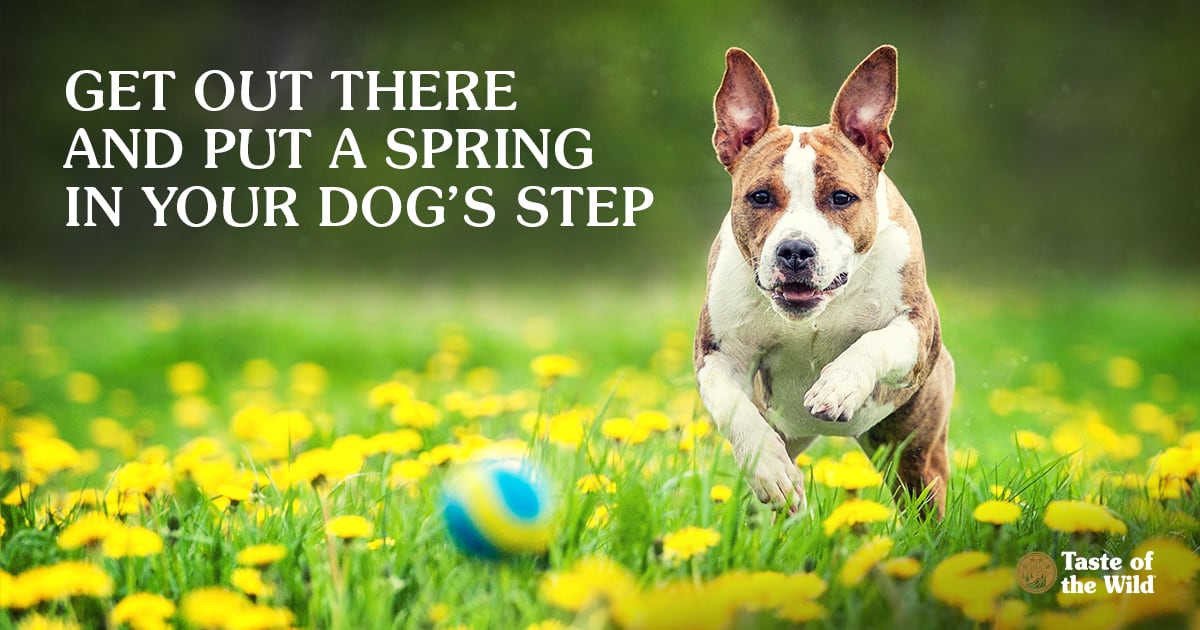
From blizzards and bomb cyclones to ice storms and snowpocalypses, there were plenty of reasons to huddle indoors with your dog this winter. Now it’s time to fling open your windows and stretch your legs outdoors. Of course, your dog would love to join you.
Regular exercise is important to your dog for a number of reasons. It helps keep your dog’s joints and muscles healthy. It works off excess energy that might otherwise be channeled into destructive behaviors. And it helps shed those extra pounds your dog may have collected over the winter.
Lucky for you and your dog, there’s another reason to exercise: April is National Canine Fitness Month.
Eight Ways to Get Moving
Of course, before you start, you should check with your veterinarian to make sure there aren’t any health issues that could prevent your dog from exercising. Once your dog has a clean bill of health, here are some ideas to help boost your activity level:
- Do downward doga. Whether you and your dog actually attend a doga class (yoga with dogs) or just do some gentle stretching together at home, it’s a great way to warm up and bond with your dog. Stretching can help your dog relax and maintain joint range of motion. Another plus: By calmly handling the paws, you can help your dog gain trust, to make nail trims that much easier.
- Create an indoor obstacle course. If the snowdrifts have left a muddy mess behind, consider creating an indoor obstacle course for your dog. Using materials you have around the house, you can lead your dog through tunnels, up and down ramps, over obstacles and around poles. Use empty cardboard boxes, hula-hoops, furniture and other soft obstacles that won’t cause injury if your dog runs into them. Entice your dog through the course with a treat to start, then progress to hand or voice signals as they get the hang of it.
- Walk the walk. Strolling around your neighborhood is one of the best ways to start your dog on the road to physical fitness. And there are all kinds of apps that help you track your daily walks. Start slow, then gradually lengthen your walk, add hills and even try short spurts of running to get your dog’s heart rate up. If you don’t have time for a daily walk, consider hiring a dog walker.
- Frolic at a dog park. Spring is when a young dog’s fancy turns to… socializing. After all those months indoors, your dog is no doubt excited to reconnect with canine pals. The dog park is the perfect place for your dog to play, bark, chase and be chased.
- Swim some laps. Dog paddling is another great low-impact exercise for dogs. If there’s a lake or creek nearby, take your dog for a dip with you. If you’re not sure if your dog can swim, purchase a doggie life vest to help him or her ride the waves. Just remember to bring fresh water so your dog won’t be tempted to drink from questionable water sources.
- Train for agility. An alternative to the indoor obstacle course, agility training is a great way to help your dog compete on an established obstacle course. It’s also a perfect way to strengthen your bond as you and your dog learn how to communicate with each other throughout the course.
- Spark the chase with lure coursing. Do you have a high-energy dog with a strong prey drive? Then lure coursing might be just the sport for you. In this event, dogs chase a white mechanical lure that zigzags across a field like a jackrabbit. This high-energy sport is best for canine athletes who are already in excellent shape and aren’t carrying extra weight.
- Join a canine fitness center. Why not help your dog work off extra energy while you’re at work? For busy dog owners, canine fitness centers are sprouting up across the country, offering anything from play sessions with other dogs to hikes, runs or swims in a pool.
If you’re a runner, you can certainly put your dog through the paces with you, as long as your dog is physically fit, isn’t a short-nosed brachycephalic breed and isn’t carrying extra weight. And while bicycling and roller skating or skateboarding might be fun for you, those sports can be dangerous when there’s a leash involved. When in doubt, ask your veterinarian. The doctor can recommend an fitness regimen that’s ideal for your dog.
The information in this blog has been developed with our veterinarian and is designed to help educate pet parents. If you have questions or concerns about your pet's health or nutrition, please talk with your veterinarian.
